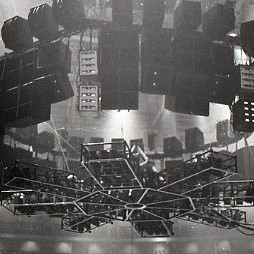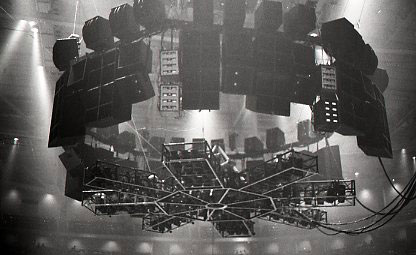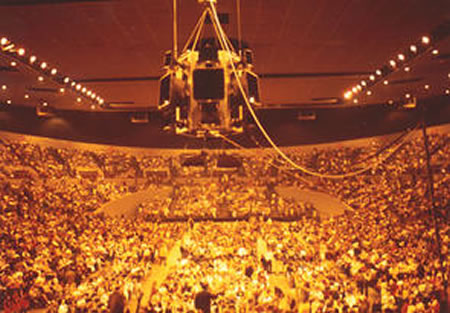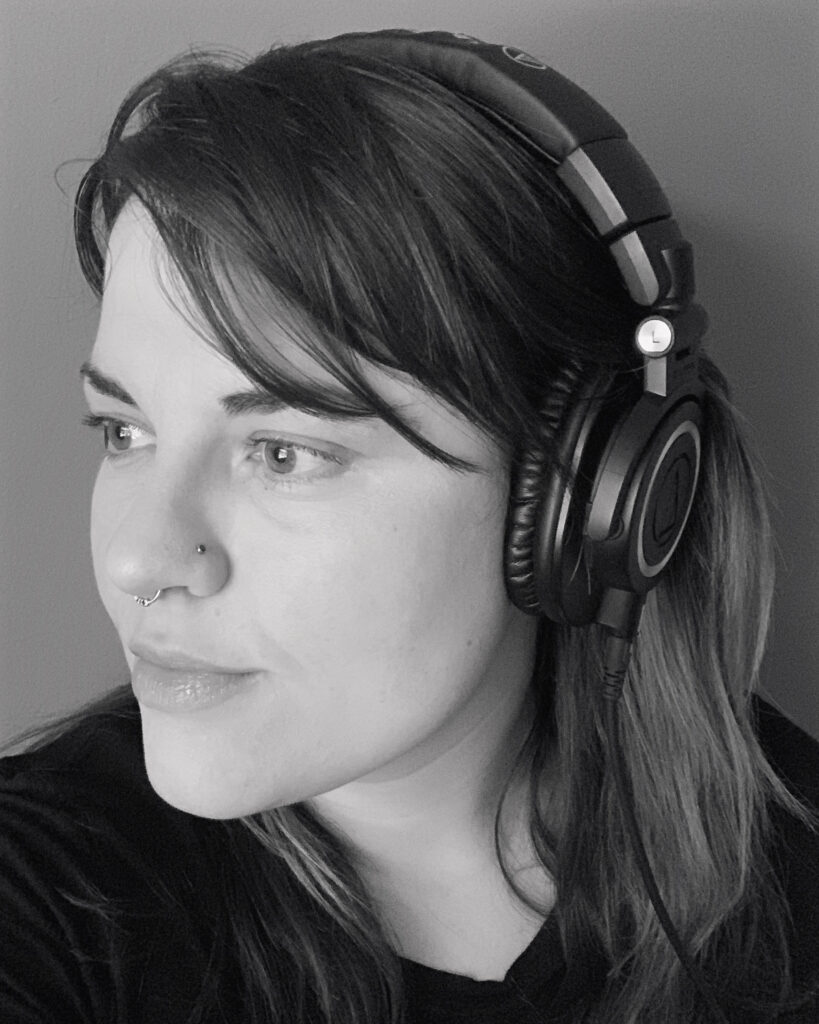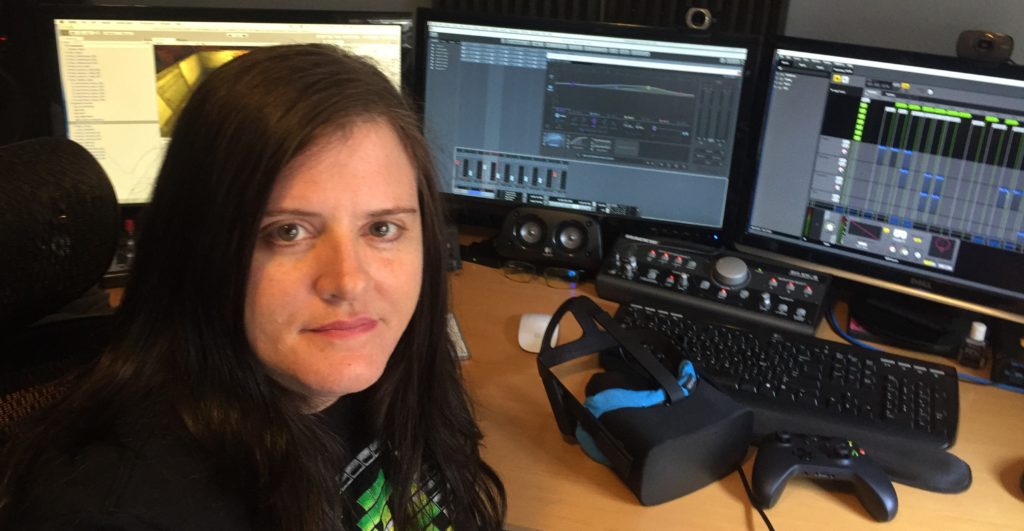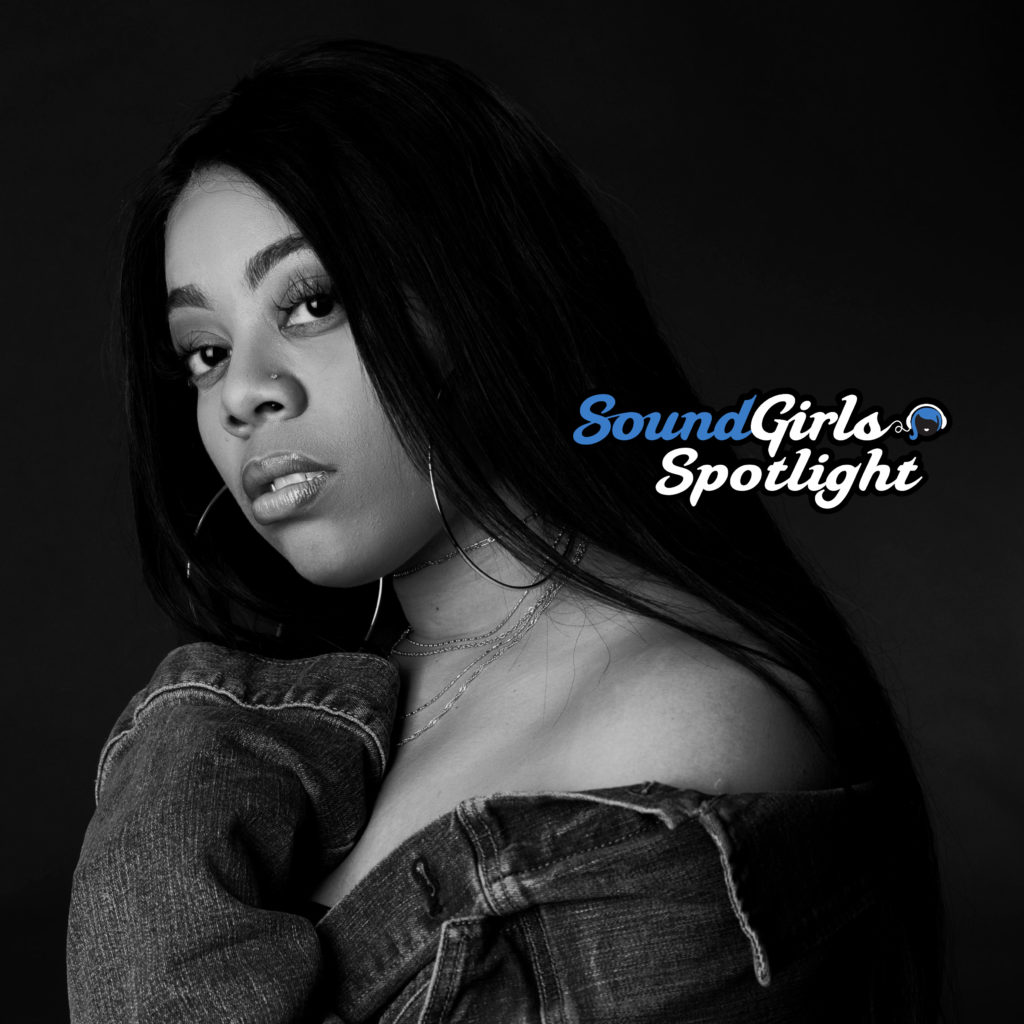In 1974, America was caught up in Watergate, Robert Redford’s Great Gatsby was in theaters, bar code scanners were just being introduced in supermarkets, and Elton John was touring his recently released “Goodbye Yellow Brick Road” album. At 18, Kathy Sander accepted an invitation to join the tour which eventually led her to a career in live sound, touring with some of the world’s biggest acts and most memorable concerts.
While on vacation in England, Kathy found herself being introduced to Elton’s tour manager who offered her a position as the ‘tea girl’ (translation gopher). Not wanting to cut short her trip she declined but had second thoughts after returning home and decided to show up in Texas for the start of the tour a few months later. Rather than being the tea girl, Kathy ended up assisting the sound and lighting crew during set up, learning from the band’s crew how to set up and tune their instruments, even lending a hand in wardrobe when needed. After testing the waters in the various departments, she learned that sound was her true love.
Clair Bros. crew chief Randy Weitzel took note of Kathy’s hard work and taught her the basics- how to mic a stage, run power, do soundcheck and run the board, etc… He observed that Kathy worked harder and was doing a better job than the newly hired Clair employee on the tour and lobbied Gene Clair to hire her. When the tour ended Gene knew Kathy could handle the road but thought she needed more experience in sound and suggested a studio job since in those days, there was no formal education for this type of work. “Most engineers came from bands, studios or bar gigs, and systems people were trained by the company they worked for.” Her next step was to move to LA where she finally found a job at Conway Recorders and again jumped right in doing whatever was needed- assisting the engineers, being tape op, setting up the instruments, running sessions, answering phones, etc.. After attending many concerts, Kathy was sure that live sound was where she wanted to be, and when the studio was sold a year later she was ready to approach Clair Bros again for a job. “The excitement of one chance to get it right in concert contrasted sharply with listening to take after take in the studio.”
Persistence paid off. Kathy made her way to Lititz, PA and showed up at the Clair facility on a Friday in late June 1976. The shop foreman, Dave Hendel told her to come back after the weekend, and when she did they seemed surprised. “For most of the day, I sat on the lawn outside and talked to the other employees,” which became the start of many great friendships. “Later in the afternoon, Hendel came walking up and said what are you doing sitting around? Get to work.” That was it, and she was hired.
Turning 21 with Elvis and No Women Allowed
It was 1977, and I had my 21st birthday out on Elvis, which was my first real tour for Clair Bros. The tour was easy, two weeks on, two weeks off, we flew in a private plane from city to city, stayed in hotels had a leisurely 10 am call. “This tour was the first time I worked with Bruce Jackson. Bruce was Elvis’s monitor engineer and he EQ’d the FoH. He taught me many things including not to take myself so seriously. He was a great kidder, an excellent teacher, and his audio skills were beyond a simple compliment. He was the first of many that taught me how and what to listen for and what sounds meant and how the systems interacted.
” The thing about Elvis’s tour is they did not want women on the crew but Clair Bros. and Bruce talked them into it. One day Colonel Parker (Elvis’s manager) decides to ride on the crew plane, and he is talking to Bruce when I walked by. I had hair down to my butt back then; the Colonel looked surprised, he turns to Bruce and says “that is a girl.” Bruce gets this big grin on his face and tells him I have been on the crew for six months and he (the Colonel) had given permission. That was the end of that controversy. Bruce and I did several other tours together after Elvis died including a Carly Simon Tour where Bruce flew us from gig to gig in his private plane. He was such an irrepressible teacher that he would have taught me to fly if I had asked.
At the time, Clair Bros. was growing rapidly, and while they had women working in the office and in the electronics shop building the Clair console, there were no other women on the road. “They made me pay my dues. I worked in the shop, speaker repair, painting, learning to solder, testing and packing the equipment for tours, eventually getting to do shows on weekends and big stadium shows. I drove equipment and was an extra hand for big stadium shows in the summer of 1976. But let me be clear, I was doing what many rookies did at Clair at that time. I did ask to go out on tour, but they were worried about one woman on a tour bus with 11 guys, and if I could handle the physical demands of lifting speakers, etc. I remember some of the roadies told me I had to lift a double horn over my head, as a test. I later found out it was only partially a joke. After a while, I guess it became moot. I could and was lifting those horns in the shop anyway. They knew I could handle the demands of life on the road because Gene had seen me work that Elton tour. I think it just took some time for the idea to foment within the ranks.
Being one of the first women in what was considered a man’s field came with its own challenges. “Just getting my foot in the door was probably the biggest challenge. Getting them to send me on the road, that took a while.” “It took a while for me to prove I could do the job, and even after I was valued enough to be requested for tours, some clients still had reservations. Clair stood up for me with our clients, and other times decided it was not worth the fight. I understood it. One particular tour was with a new woman artist, and Roy Clair wanted me to start mixing FoH for her but, although she didn’t even know me, she insisted on a guy to mix FoH. That was a big disappointment being shot down by someone who should have understood.” During the 1970s, no other companies had women roadies. It was commonplace not to hire women for the road. At Clair Bros. Kathy was given the chance to make mistakes and learn and had the support of not just management but fellow roadies who taught her, stuck up for her, and at times looked out for her. But she notes there was no special treatment, all Clair employees were treated this way. Back then doing sound was much more a physical job than it is today, gear was heavy and not always on wheels. “I always believed I could do the job; they {fellow crew} helped me figure out how I could do it.” “For most challenges and/or barriers all it took was doing the job well, and my gender became less an issue.” Most clients were open-minded about her being on the crew although her presence was usually a surprise at first and random curiosity. The men were surprised at her strength and to see her tackling a dirty and challenging job, pulling cable and loading trucks with the best of them. “Occasionally but rarely, it took some time for them to get used to me. They learned that I knew what I was doing and I earned their trust. After a while, I was just another crew member. Some clients became friends; there was a real camaraderie between the crew and artist in those days.
“At the time, it was definitely a boys club where generally the only other women on tour were artists and groupies; even stagehands were all men. “In some ways, I had an easy time. I have seven brothers, all younger. I was used to being around guys all the time. There was nothing unfamiliar about living with all that testosterone for me.” “I was respected as a female by the crew, and I was never mistreated. They always managed to find a separate shower for me, but everything else was the same. My crew bosses cut me slack for any poor decisions/mistakes on my part and continued to have faith in my abilities just like anyone else.” She found herself routinely asked back by crews and clients that she had worked with. Mike Stahl, former president of ATK states, “She was one of the best, if not the best engineer that I have ever worked with.” “I took Kathy on every tour that I did for over five years knowing that with her help, it would sound as good as humanly possible.”
When she started out, with female live sound engineers being a rarity if not unheard of, Kathy’s mentors were all men. She learned from her colleagues but mostly any FOH engineer that would teach her. Once she gained their trust, they let her EQ the system or try new things to make it sound better. There were a few-Jo Ravitch, Mike Stahl, and Roy Clair who encouraged and pushed her, giving her opportunities to come into her own. “Kathy was one of the most conscientious employees that worked for Clair Bros. She always strived to do her best. She was an asset to the audio industry. Kathy made the industry realize that gender was not an issue and that people were the only thing that mattered. She proved that” recounts Roy Clair. For most of her career, Kathy was a system tech and FOH tech.
“I really enjoyed EQing the FOH system and running a complicated live show. I thrived on a challenge. From them, I learned that there was always a way to solve a problem, I was only limited by my ability to figure it out. A very useful lesson even now.”
During the 1983’s US festival with 34 different acts performing, Kathy’s job was handling the master stage chart list and making sure that each act’s inputs came up as needed and were mic’d as requested. In 1985, she was in charge of the U.S. half of Live Aid at JFK stadium. Keeping the rotation of the extensive number of acts running smoothly and on time while coordinating with the TV people in both Philadelphia and London was not an easy job to handle. The JFK show ran extremely well, sounded fantastic and is something she is very proud of. Kathy did her share of unique and memorable gigs from presidential inaugurations to the Moony wedding in MSG. From the Amnesty International tour to Jackson’s Victory tour where the audience, parents, and kids, were singing louder than the PA. Other highlights were being on a Queen tour in South America with 100,000 Brazilian fans singing in English, and sitting behind Elton John’s drummer in MSG on Thanksgiving night 1974 when John Lennon appeared on stage with Elton and sang ‘Lucy in the Sky with Diamonds.’ “Slowly and for the first time, people in the audience started to light matches and lighters. From the stage, it looked like a sky of stars; both Elton and John were visibly moved by the audience gesture.” One of the engineers Kathy frequently worked with was Mike Stahl who acknowledged Kathy’s skill with tuning the PA system during an interview with a leading industry magazine at the time. He relayed how on Jackson’s Victory tour she took a stadium system of recently changed components that sounded terrible and by physically changing the crossover points and EQ she made it sing. “I can’t say enough superlatives about her, her attitude and her ability.”- Mike Stahl.
The equipment and technology of the 70s and 80s were quite different from what is being used today. “When I started the S-4 and the Clair console was relatively new. Many systems still had single component speaker boxes that were stacked or hung differently every gig to “splay” the sound specific to each venue. But in a matter of a few years the idea of stream-lining load in/out and set up, efficient use of truck space, consistency, and durability of equipment became driving factors in equipment change.” “The thinking in those days was that the system had to point at the entire venue. Now of course we have a different understanding of venue acoustics and the physics of sound projection, hence the line array…..etc. But in the infancy of this industry what we saw was a gradual increase in the sheer number of boxes as bands requested more and more gear. It was all about the volume, and quality even then. Monitors were small (and heavy for their size) wooden boxes that sat on the floor with a speaker and a horn. I loved EQing the house system, setting the delays, getting it just right. I always walked the venue with and without people. I used to dream about walking around with a pad to EQ from the stands instead of using walkie-talkies. Now it is common practice to use an iPad to do just that. I hoped the systems themselves would change as they have, although I have to admit I did not see fiber-optics, wireless ear monitors and digital coming quite so fast.”
Kathy worked at Clair Bros. from 1976 until 1989 during which time she was told repeatedly by the local crews that they didn’t see any other women on touring crews that came through. Toward the end of her touring career, she would occasionally hear about women in lighting or wardrobe but no other sound engineers. Things have improved since then, women engineers can be found on a wide variety of tours and at venues. Clair Bros now has a number of well-respected women engineers and even more women working in the shop. When asked what advice she would give to young women considering a career in live sound she replied, “One thing I might do is make sure she understands what life is really like on the road. Anyone wanting to work on the road should understand the pros and cons before committing. It may not be what they think. I would suggest she contact Clair or any other company she thinks is doing great work and ask the company what they would like to see from her by way of any formal training or experience. Today I’m sure it is different, there are degree programs and other opportunities to get a knowledge base and some experience. I have been told Clair now has a more formal training program for their road crews. And of course, there is always the tried and true method- Find a great band and work for them. Easier said than done, as always. It is my understanding this is still the way most FoH engineers will get to mix. ”
“For me, there has always been an underlying belief that you find the best people working in any field and lobby like crazy to work and learn from them. Clair Brothers were/are the best in the field.”
“In closing, most of your colleagues, crew, staff, and clients will not think twice about having a woman on their crew anymore. That is some small measure of progress. In any job where men have been the principals, it is doing a job well that changes attitudes. The music business was not as sexist as one might have thought or expected in those days. In many ways, it simply came as a complete surprise to everyone that I could do the job. Being surprised is not all bad. There are so many experiences and people that encouraged me. The list is very long, but I would most like to say thank you to the ones that never blinked when I turned up to work. They are the real heroes of any story about opening this door. I was lucky to have had all those opportunities, lucky to have made so many good friends. It is the people I miss when I think about those days.” After leaving Clair Bros. in 1989, Kathy made a complete career change and became a geologist. She is currently living in Denver and has recently retired. She encourages any of today’s women live sound engineers passing through town to contact her. “If you would like to show off your rig, I would very much welcome connecting with the women of live audio, visiting, seeing, and hearing the state-of-the-art in both monitors and FoH.”
We here at SoundGirls.Org would like to express our gratitude to Kathy for opening the door for the rest of us.
Find More Profiles on The Five Percent
Profiles of Women in Audio
